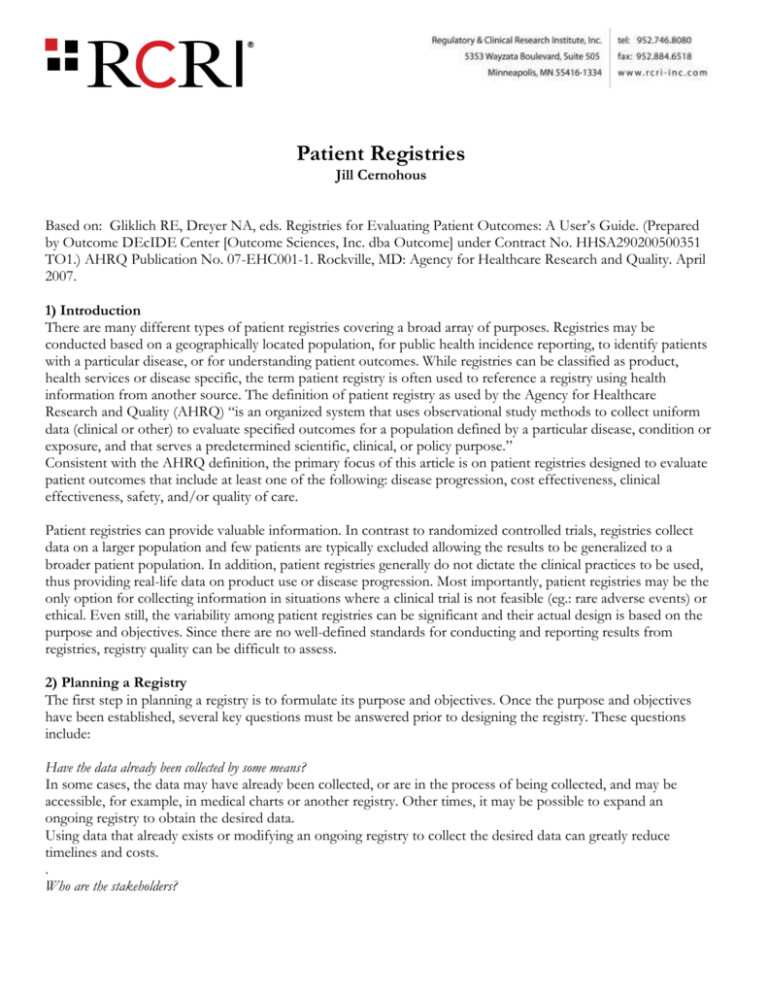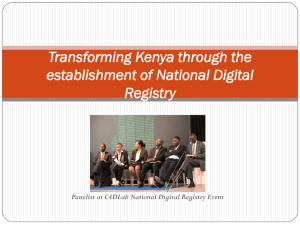Patient-Registries-W..
advertisement

Patient Registries Jill Cernohous Based on: Gliklich RE, Dreyer NA, eds. Registries for Evaluating Patient Outcomes: A User’s Guide. (Prepared by Outcome DEcIDE Center [Outcome Sciences, Inc. dba Outcome] under Contract No. HHSA290200500351 TO1.) AHRQ Publication No. 07-EHC001-1. Rockville, MD: Agency for Healthcare Research and Quality. April 2007. 1) Introduction There are many different types of patient registries covering a broad array of purposes. Registries may be conducted based on a geographically located population, for public health incidence reporting, to identify patients with a particular disease, or for understanding patient outcomes. While registries can be classified as product, health services or disease specific, the term patient registry is often used to reference a registry using health information from another source. The definition of patient registry as used by the Agency for Healthcare Research and Quality (AHRQ) “is an organized system that uses observational study methods to collect uniform data (clinical or other) to evaluate specified outcomes for a population defined by a particular disease, condition or exposure, and that serves a predetermined scientific, clinical, or policy purpose.” Consistent with the AHRQ definition, the primary focus of this article is on patient registries designed to evaluate patient outcomes that include at least one of the following: disease progression, cost effectiveness, clinical effectiveness, safety, and/or quality of care. Patient registries can provide valuable information. In contrast to randomized controlled trials, registries collect data on a larger population and few patients are typically excluded allowing the results to be generalized to a broader patient population. In addition, patient registries generally do not dictate the clinical practices to be used, thus providing real-life data on product use or disease progression. Most importantly, patient registries may be the only option for collecting information in situations where a clinical trial is not feasible (eg.: rare adverse events) or ethical. Even still, the variability among patient registries can be significant and their actual design is based on the purpose and objectives. Since there are no well-defined standards for conducting and reporting results from registries, registry quality can be difficult to assess. 2) Planning a Registry The first step in planning a registry is to formulate its purpose and objectives. Once the purpose and objectives have been established, several key questions must be answered prior to designing the registry. These questions include: Have the data already been collected by some means? In some cases, the data may have already been collected, or are in the process of being collected, and may be accessible, for example, in medical charts or another registry. Other times, it may be possible to expand an ongoing registry to obtain the desired data. Using data that already exists or modifying an ongoing registry to collect the desired data can greatly reduce timelines and costs. . Who are the stakeholders? Stakeholders may include regulatory authorities, product manufacturers, health care providers, patients, or physicians. Stakeholders may have a significant influence on registries by imposing specific requirements or restrictions, determining the available budget, or desiring specific information from the registry. What is the scope of the registry? When defining the scope, several factors must be considered such as when the data need to be available for analysis, the required scientific rigor, the characteristics of data to be collected, the target population, specific variables (size, setting, duration, geography, financing, etc), feasibility, and costs. In addition, the scope may be affected by regulatory requirements, reimbursement decisions, national research interests, public health policy, or manufacturer interests. Who should comprise the registry team? A registry team should be assembled consisting of, as appropriate, individuals with expertise in the following areas: subject matter, epidemiology and/or biostatistics, data collection/management, legal/patient privacy, quality assurance, and project management. 3) Designing a Registry Registries are observational studies often comprised using common study models such as cohort, case-control or case-cohort. A cohort study follows a group of patients with a specific characteristic to see if they develop a particular endpoint or outcome and may contain comparison groups. A case-control study is used when trying to determine the proportion of patients with or without a specific outcome that has or had an exposure or characteristic of interest within the same or alternate registry. This design is effective for studying rare diseases. A case-cohort study is a variant of a case-control study; however, each control has an equal probability of being sampled from the source population while with a case-control study, control selection is not random and is affected by the length of follow-up. Once the study model has been determined, the target population (the population to which the results are meant to apply) should be identified along with any subpopulations. While it is desirable to select patients representative of the target population, it is usually difficult to obtain patients that are completely representative from a statistical sampling perspective due to budgetary and/or practicality issues. Whether or not to include a comparison group should also be evaluated. Comparison groups are not required for registries being used for descriptive purposes; however, they should be used to distinguish between alternative decisions or assess differences or associations between groups. Comparisons are more complex in registries than within a clinical trial and require the use of various designs and analytic strategies to control for confounders. Lastly, the sample size, registry duration, expected interim analyses, required clinical relevance, and use of the registry for regulatory purposes should be determined. Additional resources to support the registry should also be considered, such as an executive or steering committee, data safety monitoring board, clinical events committee, liaison (important for large registries), scientific board and/or publications committee. Data Collection Based on the registry purpose and objective, the data to be collected need to be carefully and clearly defined. Any outcomes to be measured should be prioritized and data of minimal importance should not be collected. Data collected should be relevant with potential clinical and scientific value, be selected by a team of experts, and rely on established guidelines when possible. After identifying the data to be collected, it is likely that not all desired data will be reasonably available. Data collected should incur minimal burden to the physician and/or patient, and be available for all patients. Highly burdensome data, when required, should only be collected from a subset of patients, if possible. Several data sources exist, such as from physicians, patients, medical records, or other databases. Data collected specifically for the purposes of the registry are considered primary data while data normally collected for other purposes are referred to as secondary data. When secondary data are utilized, agreements should specify ownership of the source data and clearly allow data to be used by the registry. Prior to initiating the registry, it is recommended that data mapping be conducted to identify data sources and how data sources will be integrated. This will help ensure the ability to collect desired data and can provide beneficial information for defending data integrity later on. Pilot testing is also recommended to evaluate the ease of collecting the data, determining the expected rate of missing data, and assessing the validity of data. Pilot testing should be conducted at a point when changes can still be made. Data element formats and definitions from clinical data standards or widely used clinical data sets should be used when possible for consistency and to minimize training requirements. In addition, how missing or unknown data will be handled should be determined prior to the initiation of the registry as well as a plan for patients who do not complete the registry. Lastly, a method for determining patient identifiers should be established. Ideally more than one patient identifier should be used for the registry as identifiers may change or be inaccurate due to errors or patients providing false information. The best identifiers are unique with no patient information incorporated to minimize privacy concerns. Ethical and Patient Privacy Considerations As a result of an analysis of the Belmont Report regarding the conduct of ethical research in human subjects, a set of uniform regulations were developed known as the “Common Rule.” The Common Rule is a legal requirement for all research conducted or supported by several Federal departments and agencies who adopted the rule; however, research institutions may require compliance for all human subject research regardless of funding or support. Human subject research is defined as all research involving individually identifiable patient information obtained by the investigator conducting the research. Thus, if the research is being conducted on existing data where patients cannot be identified, it is not required to comply with the Common Rule. The Rule requires a written agreement from each institution stating its compliance to the Common Rule (most commonly called a Federalwide Assurance). The Rule also requires the prospective review and approval of the research by an Institutional Review Board (IRB), and requires informed consent of each patient unless the study meets certain requirements or the IRB grants a waiver. The Food and Drug Administration (FDA) also requires informed consent except for in an emergency and, thus, any registries conducted to support labeling of an FDAregulated product should obtain informed consent. Patient informed consents must be legally effective and obtained voluntarily. At a minimum, the informed consent should contain a description of the purpose and operations of the registry, activities involved, a statement that indicates participation is voluntary, instructions on how to withdraw at any time, and expected risks and potential benefits from participation. Informed consents may be required to contain additional elements as applicable by the Common Rule or other regulations and may contain language for potential future research. Any future research conducted must still be reviewed by the IRB. Conflicts of interest and incentives for providing registry health information should be carefully evaluated for undue influence on both patients and health care providers. The Health Insurance Portability and Accountability Act (HIPAA) was implemented in the United States in 1996 (collectively referenced as the Privacy Rule). This Act regulates the use and disclosure of identifiable patient information by “covered entities” or health care providers and health care insurance plans. The Privacy Rule applies to most registries and requires legally effective authorization from individual patients for the use of their identifiable information for research purposes. This authorization can be incorporated into the informed consent document but cannot encompass any future unspecified use of the data for a different research purpose. Authorization may be waived or altered by the Privacy Board or IRB if certain criteria are met. Any state laws that are more protective to the confidentiality of health information still apply. Registries using de-identified health information (limited data sets), or registries for public health activities generally do not require patient authorization. Public health activities include surveillance practices such monitoring risk factors or diseases, health oversight activities such as audits or investigations, and FDA- regulated products or activities such as adverse event reporting, product tracking and product recalls or repairs. Quality improvement/assurance activities may also not require patient authorizations. Early discussions with regulatory agencies, IRBs, institutions, legal consult and/or funding organizations are strongly recommended to ensure compliance with applicable requirements and minimize delays. 4) Conducting a Registry Prior to initiating a registry, a well-designed registry plan or “protocol” needs to be developed. At a minimum, the plan should contain the purpose of the research, a detailed process for obtaining informed consent or justification if informed consent is not required, safeguards for protecting the confidentiality of registry data, and any other information as required by the IRB or applicable regulations. Implementing a well-developed patient recruitment and retention plan is key in ensuring the quality of registry data. Prior to initiating the registry at a site, detailed discussions should occur with the hospital and physicians to confirm they have the capability to collect the required data and meet registry requirements. An appropriate balance between the burden of participating in the registry and any rewards must be maintained. Incentives for participating in the registry may include recognition of the hospital and/or physicians, providing the physicians with useful data or reports, or monetary incentives providing they do not exceed fair market value. Partnerships with government agencies, patient advocacy groups, health maintenance organizations (HMOs) and/or industry may prove beneficial in recruiting physicians and patients. Methods for retaining physicians and patients may include ongoing communications, use of an advisory board, providing telephone help lines, sending out newsletters and/or customer satisfaction surveys, conducting additional training meetings, and fulfilling commitments. Well-designed paper or electronic case report forms are required for the collection of registry data. If the data are intended to be used by FDA, the requirements of 21 CFR Part 11 should be met. A well designed data dictionary including data definitions and data validation parameters should also be developed along with a manual containing all registry-related documents. This manual should contain copies of the registry plan, procedures, forms and any other required documents as well as instructions on documentation practices, patient identification numbers, required training, etc. An adverse event monitoring system should be developed prior to initiating the registry for detecting, processing and reporting adverse events. The plan should include any applicable regulatory requirements and be discussed with the appropriate health authorities in advance to confirm appropriateness. Sites should be trained on the system as well as general obligations. A commonly used adverse event reporting plan that is suitable for most registries requires the sites to immediately report all serious adverse events, including those from comparators, to the registry sponsor who then assesses and reports the event to the manufacturer or FDA according applicable regulations The collection of adverse event data is highly dependent on the type of registry conducted, products involved, sponsor(s) of the registry, and data to be collected. Depending on the registry objectives, all adverse events or only a subset of adverse events may be collected. It is also possible to have a registry that does not collect any adverse event data. If adverse event data are collected, the coding of events into a standard nomenclature should be done by a trained expert to maintain accuracy and consistency. Quality assurance should be an integral part of conducting any registry. High standards should be applied especially to registries evaluating patient outcomes. The level of quality assurance may be limited by budget constraints and thus a risk-based approach to determine the most critical sources of potential errors should be used. Prior to initiating a registry, structures, processes, policies and procedures should be implemented to ensure data quality. In addition, manual and electronic edits checks should be used to detect missing, incorrect, out of range or logically inconsistent values. A systems security plan should also be implemented including periodic security assessments. Adequate training of registry staff is critical as well as onsite audits at a sampling of sites. Data across sites should be compared and sites should be provided immediate feedback on any identified issues when possible. 5) Analysis of a Registry Prior to conducting the analysis for a registry, a scientifically rigorous Statistical Analysis Plan must be developed. Contrary to a randomized controlled study, a preliminary analysis conducted during the development of the plan may be warranted to understand the data. Due to the complexities and differences between registries, there are no standard statistical approaches; however, most typical cohort study analytical methods can be applied. The analysis of registry data should disclose how the study was developed. For example, was the analysis based on the results of hypotheses or prior experience? In addition, the analysis should include the characteristics of the patient population along with any treatments or exposures and all endpoints or outcomes. All results should be presented in a time-appropriate fashion and a careful evaluation of any potential bias must be conducted. Lastly, the quality of data should be assessed. Factors used to determine the quality of data include whether or not important covariates were collected, if the data are reasonably complete, and how missing data were handled. 6) Conclusions Registries can serve as an important tool for collecting data regarding the quality of care, safety and/or efficacy of a product or service, the natural progression of a disease, or cost effectiveness. The design and implementation of a registry can vary substantially based on the purpose and objectives but proper planning is critical for the success of all registries. Planning a registry encompasses the appropriate design, execution, analysis and quality assurance measures to ensure data quality and acceptability by the scientific community. For additional information, please refer to the “Registries for Evaluating Patient Outcomes: A User’s Guide” by the Agency for Healthcare Research and Quality (April 2007) or contact an RCRI representative.







